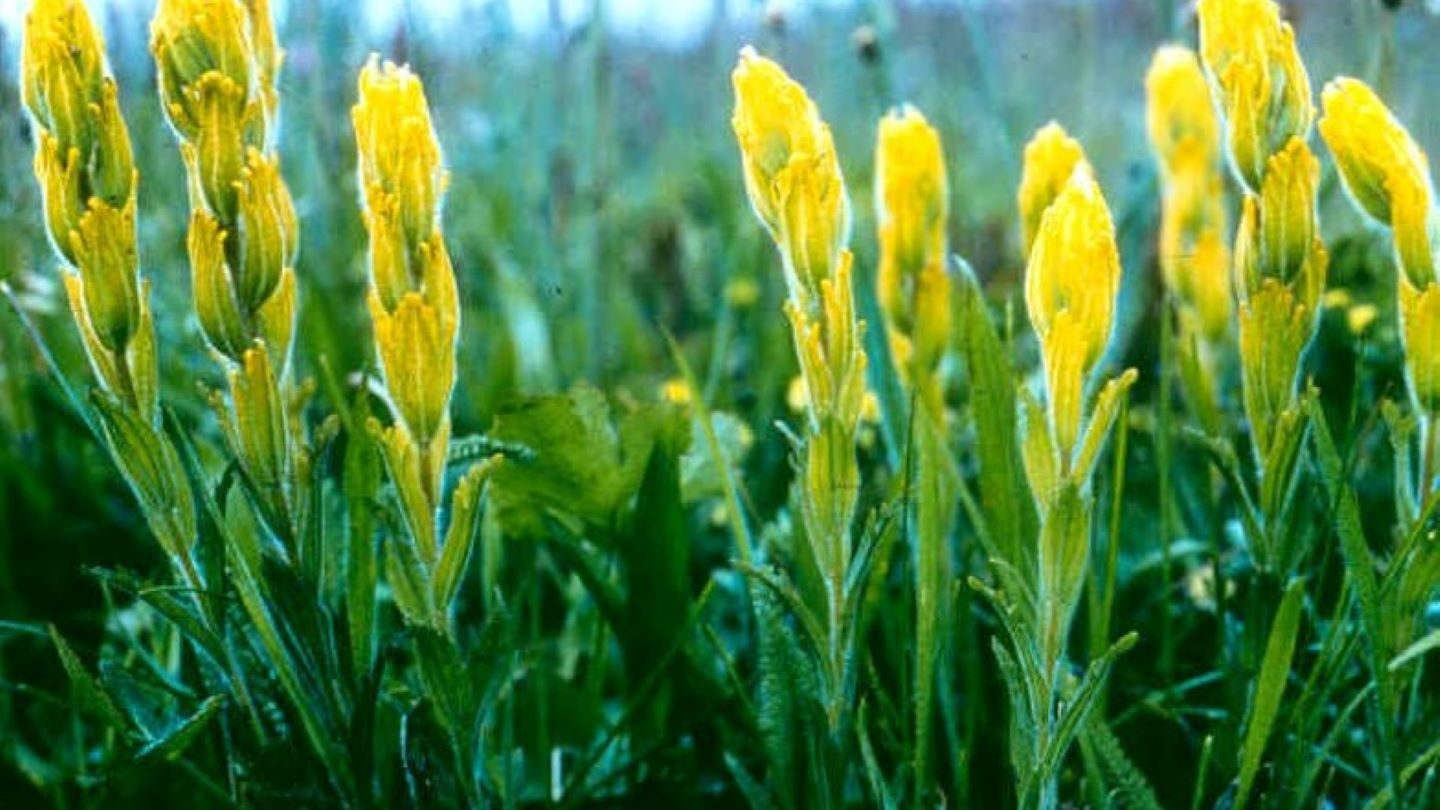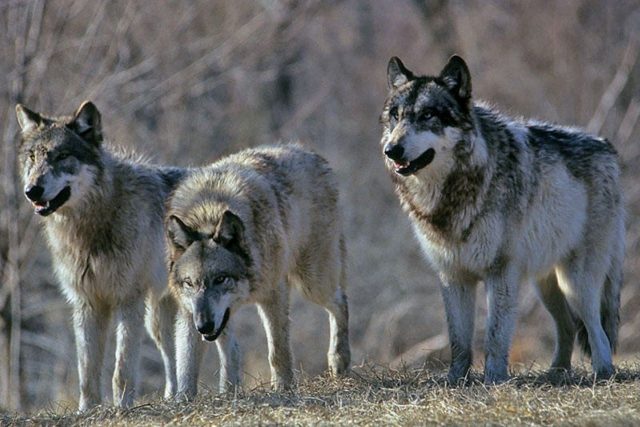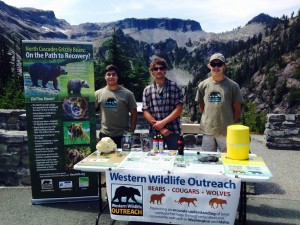by Hallie Sykes, Farmer Frog Garden Educator, Woodland Park Zoo Advanced Inquiry Masters Degree Program
On a chilly, yet sunny, spring afternoon this April a dozen community members gathered to learn how to share the landscape with black and grizzly bears in a workshop hosted by Western Wildlife Outreach. The workshop featured Zoe Hanley, Senior NW Representative at Defenders of Wildlife, whose work involves promoting non-lethal deterrents as a tool to prevent gray wolf depredation on livestock. Defenders is also involved with supporting grizzly bear coexistence in the North Cascades and Selkirk ranges of Washington state.
The workshop was held at Farmer Frog in the Paradise Valley Conservation Area which is 700-acres of undeveloped land set aside to protect the headwaters of Bear Creek, one of the most productive wild salmon streams left in Western Washington. This landscape provides a refuge for bears, cougars, coyote, bobcat, deer and other wildlife.
Western Wildlife Outreach planned the training to educate people about bear biology, black and grizzly bear identification, how to handle bear encounters, and securing bear attractants around the home and campsite.
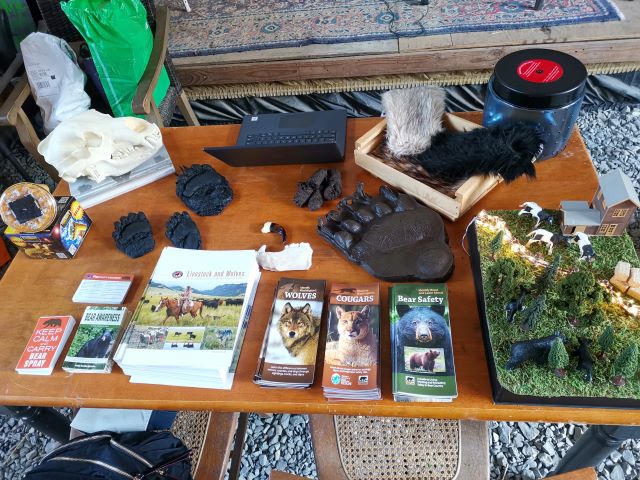
Bear Safety & Coexistence Workshop props: bear safety education materials, a bear-proof storage can, bear tracks, skull and scat example, a farm diorama. Photo credit: Hallie Sykes
Participants gathered eagerly and several shared their bear stories.
“I have bears every year,” said Jeanne Weiss, a resident of the area surrounding Paradise Valley. Jeanne knows that we are living alongside wild animals because she documents them. “We have cameras and we’ve seen bears, coyotes, bobcats, deer, cougars.”
She came to the workshop hoping to learn strategies to deal with bears visiting her unfenced backyard where her dogs some times run into them. Hanley mentioned that half of bear encounters in WA state are caused by off leash dogs because the bear ends up chasing the dog back to the human. Hanley reassured Jeanne that bear spray and the workshop training would be a key tool for handling such an encounter in the future.
Adel Krupp, who attended the workshop with her two teenagers, also wanted to learn how to coexist with wildlife at home. The only participant this day with livestock (chickens) she got some key advice from Hanley about using a three strand electric fence to surround the coop, including the top of it, as a deterrent to bears and other wildlife.
Krupp will also follow Hanley’s advice to take down the bird feeders from April to November when bears go into denning season. Winter is actually the only time when song birds are in need of food supplementation to help get through the winter months participants learned.
Zoe Hanley compares the track patterns of a Kodiak grizzly bear to a black bear. The grizzly track she is holding is much larger than grizzlies in Washington, which is home to less than a dozen in the easter side of the state. An encounter with one of Washington’s 20,000 black bears is much more likely. Photo credit: Hallie Sykes
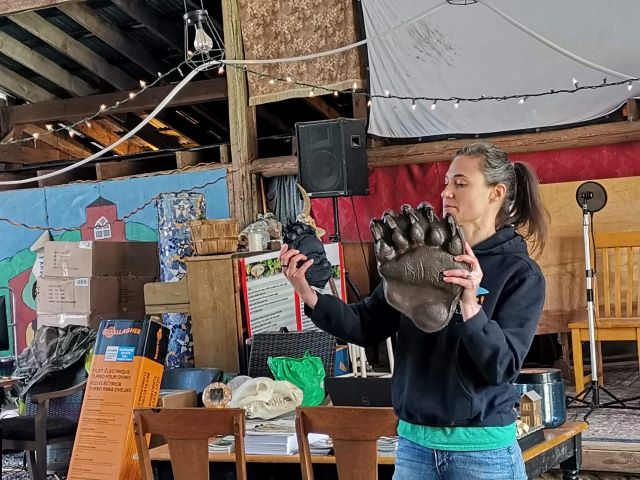
Bear encounters are more likely to occur during the months of March through November when bears are working to consume calories to make it through their denning/hibernation season. An encounter with a bear has significant risks for people and pets and also bears themselves. If they become a nuisance the bear must be trapped, relocated or even killed if they’ve become habituated to human provided food sources.
“It’s a privilege to see them but we don’t want to be drawing wild animals in close to our homes. When they get acclimated to human foods that’s when bears get killed,” said Hanley.
While workshop participants generally didn’t have a lot of concerns themselves about bears, several expressed they felt people in their community were more afraid of bears than they needed to be. Bear attacks are extremely rare. Only 2-5 people die per year in all of North America.
Hanley stated the best thing to do is try not to surprise the bear. A surprised bear may display behaviors such as huffing, teeth clacking, rocking on legs, and even a fake-out “bluff charge” where they sprint and then stop short. Other behaviors you might witness during a bear encounter include more of a curious stance on their hind legs (used when a bear wants to get a better look at something).
If either a black or grizzly bear gets too close to you – stand your ground!
Have bear spray ready, don’t turn your back or run, back up slowly. If the bear keeps approaching deploy the bear spray by aiming it at the ground about eight feet in front of you. Spray to create a wall of the deterrent in front of you in order to stop the bear’s forward movement. In the rare case that doesn’t work and the bear attacks, fight back.
Other tips to avoid these situations are: make noise on the trail, keep children close in sight, hike with dogs on leash, don’t approach dead animals, carry bear spray, keep it at hand and know how to use it. At your campsite don’t store food or smelly things like deodorant in your tent. Pack it in, pack it out.
After learning about minimizing attractants, learning about bear behavior and safety tips for dealing with them, participants went out behind the barn to practice using bear spray. Hanley recommends carrying two bear spray canisters when backpacking because the spray can be exhausted after three bursts of 2-3 second sprays.
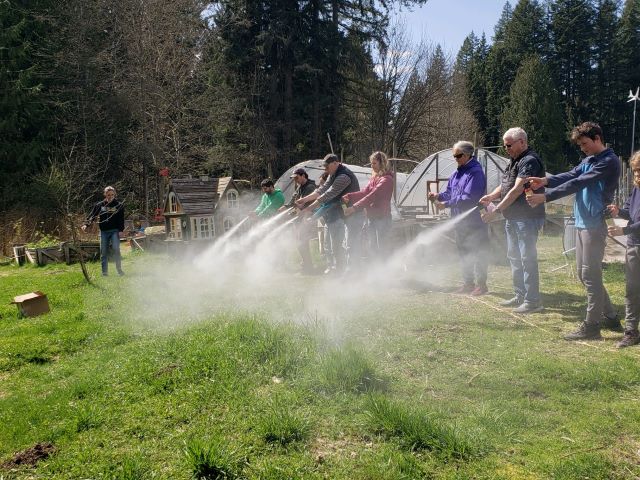
Workshop participants line up and deploy practice cans of bear spray, aiming at the ground in front of them to create a wall of spice, versus aiming directly at a bear. Photo credit: Lynn Okita
Workshop attendees appreciated the opportunity to learn a new skill and got to take home a free can of bear spray donated by Counter Assault. They also appreciated learning what to do if bear spray gets in their own eyes as well.
Water, Air, and Time were the three first aid words to remember.
Rinse with water and don’t rub your eyes since the grains of capsaicin can aggravate the eye if rubbed. Allow your eyes to use tears to move the spray out. Keep them open and exposed to the air. In time the discomfort will pass, only lasting for 30 minutes or so.
All of this is a better alternative than a bear attack, which Hanley again mentioned is very rare. Even with her vast experiences in the wilderness she has never had to use bear spray. However, it does provide peace of mind.
To learn more about Bear Identification and Bear Safety, visit these links here on the Western Wildlife Outreach website and join this group of newly empowered community members in promoting awareness and peaceful coexistence with our wild animal neighbors.

